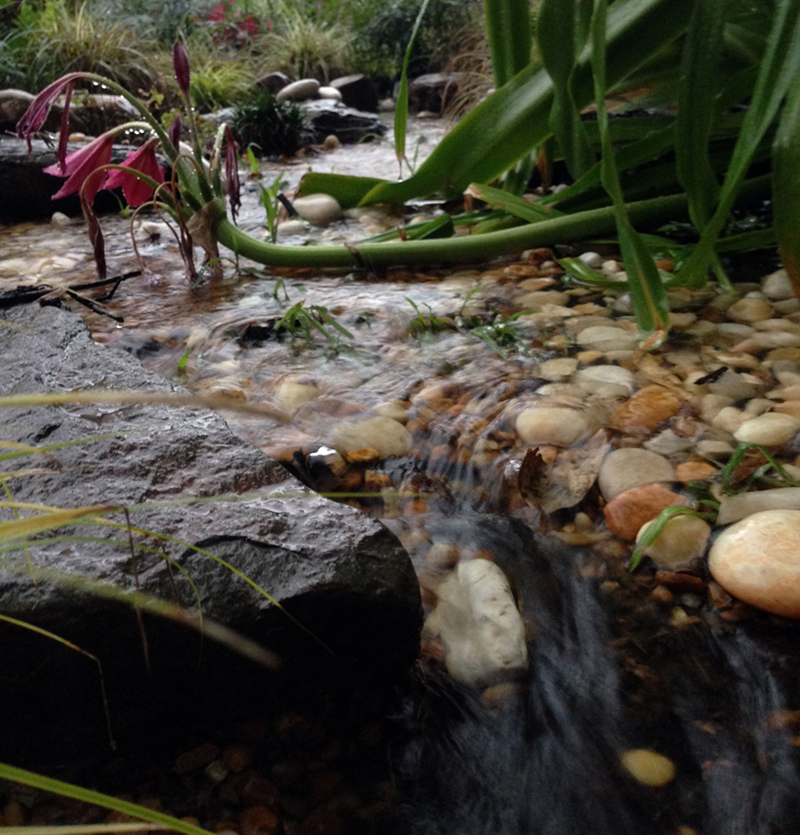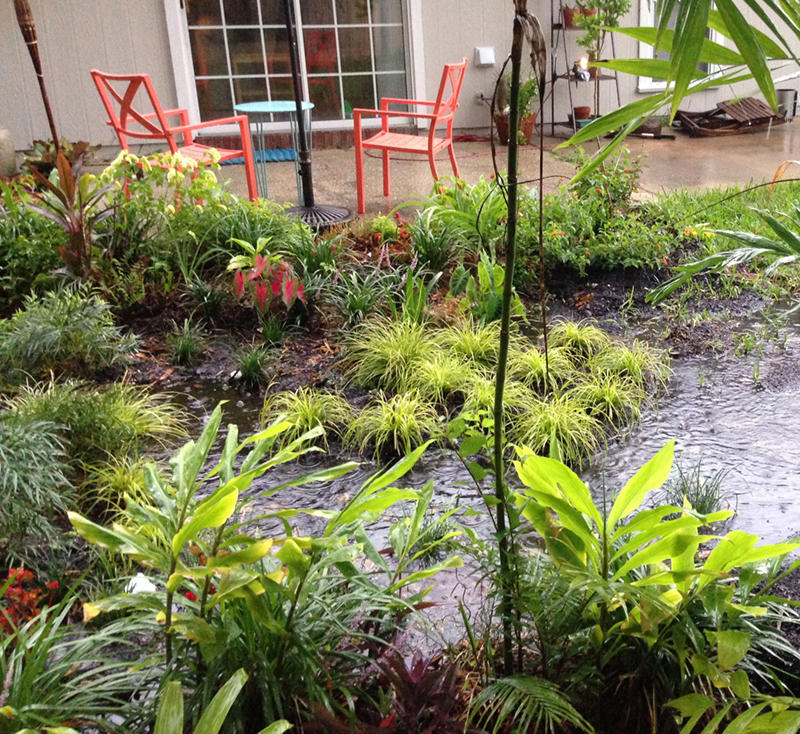Tired of watering all the time, while praying for rain and smaller water bills? If your garden is planned, prepared, planted and watered properly, you can have a beautiful yard and save thousands in the long run. Here’s how to get the most from your water this summer.
Start from the ground up
Plan your preemptive strike against drought. Get to know your yard, and note which areas tend to dry out quickly or develop puddles after it rains. Places that are especially prone to drying out include the soil under large and thirsty trees, or under the eaves of your roof.
Your soil type plays a big part in how often you’ll need to water. Loose, sandy soil holds very little moisture, so much of the water you dump on it slips away and goes to waste.

Treat runoff as if it’s money — don’t let it slip through your fingers.
The soil you’re after is the rich, dark crumbly stuff called loam. Adding topsoil (good), composted manure (better) or compost (best) to your soil makes it loamy and performs some pretty amazing feats. It encourages beneficial organisms, improves the soil structure and texture, aerates the soil and helps it retain moisture.
If your garden is too big to amend with better dirt, consider growing vegetables in a raised bed, where you can easily focus your watering efforts and amend the soil without breaking the bank.
Choose the right plants
When it comes right down to it, you have to look at your water bill and ask yourself: Is that tomato vine really worth the absurd amount of money you spend each month?
If growing your own food is what motivates you to shell out for those big bills, consider raising cowpeas, hot peppers, okra or other edibles that require less water. Choose drought-tolerant plants whenever possible, unless you’re planting in a space that rarely dries out.

Texas sage is just one of the many plants that thrives without irrigation.
If you simply have to grow thirsty plants, group them together so you can easily water them without wasting a drop. You might even choose to submerge a perforated pond liner so water has a better chance to collect.
Native plants are often, but not always, good choices for a drought-tolerant landscape since they’re well adapted to the unique conditions of your region. Succulents and cacti are well equipped to handle drought because they store moisture in their leaves and stems.
If you have a lawn that requires regular irrigation, save money by replacing it with a mass of groundcovers like wooly thyme or liriope.
Prepare plants for drought
When properly planted and cared for, plants can get by with a lot less water. Let’s say you planted a tomato plant too high in the soil, giving it a weaker foothold and fewer roots to absorb water. That plant might then become susceptible to pathogens like bacterial wilt or root knot nematodes, and would wilt every afternoon as if dying of thirst.
You might then water it more often, but at that point all the irrigation in the world couldn’t save it. Meanwhile, you’re overwatering the adjacent plants in your vegetable garden and opening them up to the possibility of disease.

Sometimes plants only appear thirsty. This tomato could be infected by a wilt disease or nematodes.
Fertilize your plants, but only according to label instructions. Synthetic fertilizers are fast-acting, but don’t actually improve upon the soil itself. Using too much synthetic fertilizer can burn the plants and damage the soil, causing irreparable damage. Organic fertilizers, on the other hand, rarely burn plants, and enrich the soil itself over time.
Water slowly, deeply and infrequently
There’s a good chance that you water your lawn or garden a lot more than is really necessary. Grass generally only needs one or two inches of rain a week to do well — and even less if it is a vigorous variety that has been planted on good soil.
If you water plants or turfgrasses too often, they become at risk for bacterial and fungal infections. This also encourages plants to develop shallow roots; meaning that they are more easily uprooted in storms, and they can’t take advantage of the moisture deeper underground in the event of a drought.
The upper layer of soil also dries out more quickly, effectively wasting water. The trick is to irrigate slowly, deeply, infrequently and only where it’s needed. Instead of watering a little every day, water once a week for long enough that the water can really soak in.
Slow down the runoff
Watering slowly is a big part of the solution, but you can take it a step further and slow the rainwater itself. Your goal is to take advantage of as much water as possible before it sinks or drains away.
If it’s legal in your area, install rain barrels that collect water from your roof, and save it for a not-so-rainy day. If you see a lot of runoff washing off your driveway into the gutter, replace the slab of concrete with permeable pavers that allow water to sink into your soil.
You can also divert the runoff to a rain garden — that is, a man-made or natural depression in your yard with plants that tolerate both drought and flooding.

Rain gardens collect, absorb and filter runoff.
Create ‘dry creek beds’ that carry runoff from your downspout to the rain garden by digging a small ditch and lining it with gravel and rocks. Sometimes the most practical solutions are the most elegant.
When to water
Water once a week — unless, of course, that’s not enough. Don’t bother watering plants if they’re not complaining, but do water plants that tend to wilt during a dry spell. If you’re able, transplant these thirsty plants to a part of the garden that you can water all at once without wasting a drop, or consider replacing them altogether.
Keep in mind that new plantings will always need more water than established ones, and watering them deeply will help them resist drought in the long run. Some turfgrasses, such as Bermuda, zoysia and St. Augustine, go brown and dormant in drought but quickly return when rainfall resumes.
The best time to water the lawn and garden is in the morning, ideally when it’s overcast. If you water in the heat of a summer afternoon, much of that water evaporates before it can be absorbed. You can water in the late afternoon since the sun is no longer as strong, but don’t water in the evening.
If water collects on foliage overnight, it is a prime location for bacterial and fungal diseases to develop. If you must irrigate at night, soak the soil rather than the plant itself.
And here’s one last consideration: Check the forecast and Doppler radar to make sure a downpour isn’t about to do the job for you.
Related:
- Edible Landscaping: Ornamental Plants You Can Eat
- Landscaping Cheat Sheet: 4 Smart Timesavers for Your Yard and Garden
- Choosing the Best Annuals for Your Garden
from Zillow Blog - Real Estate Market Stats, Celebrity Real Estate, and Zillow News http://feedproxy.google.com/~r/ZillowBlog/~3/IODlEpHIN5k/
via Reveeo
No comments:
Post a Comment